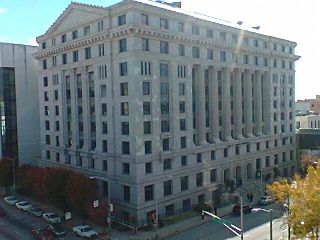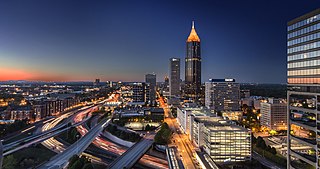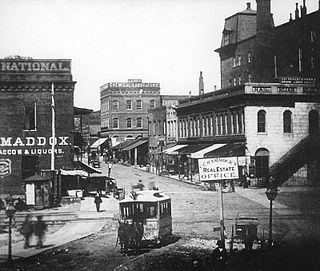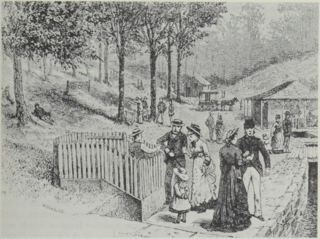Related Research Articles

Fulton County is a county in the north-central portion of the U.S. state of Georgia. As of the 2020 United States census, the population was 1,066,710, making it the state's most populous county and its only one with over one million inhabitants. Its county seat and largest city is Atlanta, the state capital. About 90% of the City of Atlanta is within Fulton County; the other 10% is in DeKalb County. Fulton County is part of the Atlanta-Sandy Springs-Alpharetta, GA Metropolitan Statistical Area.

East Point is a suburban city located southwest of Atlanta in Fulton County, Georgia, United States. As of the 2020 census, the city had a population of 38,358. The city name is derived from being at the opposite end of the former Atlanta & West Point Railroad from West Point.

Sandy Springs is a city in northern Fulton County, Georgia, United States, and a suburb of Atlanta. The city's population was 108,080 at the 2020 census, making it Georgia's seventh-most populous city. It is the site of several corporate headquarters, including UPS, Newell Brands, Inspire Brands, Focus Brands, Cox Enterprises, and Mercedes-Benz USA's corporate offices.

Buckhead is the uptown commercial and residential district of the city of Atlanta, Georgia, comprising approximately the northernmost fifth of the city. Buckhead is the third largest business district within the Atlanta city limits, behind Downtown and Midtown, and a major commercial and financial center of the Southeast.

State Route 141 (SR 141) is a 34.1-mile-long (54.9 km) state highway that runs southwest-to-northeast in the northwest part of the U.S. state of Georgia. It connects the Buckhead area of Atlanta with Cumming. Its routing exists within portions of Fulton, DeKalb, Gwinnett, Forsyth counties.

Buckhead Village is a neighborhood of Atlanta, Georgia, one of 42 neighborhoods in the larger Buckhead district and the community's historic business section. The Village as defined by the city as the area between Piedmont Road, Peachtree Road, and Pharr Road.
There were several historic mills around the metro Atlanta area, for which many of its current-day roads are still named. Most of the mills date back to the 1820s and 1830s, and were built along the area's many streams. The locations of many of these mills are shown on a map of 1875 showing U. S. military operations around Atlanta in 1864. This map is now located in the U. S. Library of Congress but can be seen on the webpage linked here.
Historic ferries operated on rivers around Atlanta, Georgia area, and became namesakes for numerous current-day roads in north Georgia. Most of the ferries date to the early years of European-American settlement in the 1820s and 1830s, when parts of the region were still occupied by cherokee and other Native American communities.

Westview Cemetery, located in Atlanta, Georgia, is the largest civilian cemetery in the Southeastern United States, comprising more than 582 acres (2.36 km2), 50 percent of which is undeveloped. The cemetery includes the graves of more than 125,000 people and was added to the Georgia Register of Historic Places in 2019 and the National Register of Historic Places in 2020.

Garden Hills is a neighborhood in the Buckhead section of Atlanta, Georgia between Peachtree and Piedmont Roads, bordered on the north by Pharr Road and on the south by Lindbergh Road. In 1987 the neighborhood was given historic district status by the city of Atlanta.

Chastain Memorial Park is the largest city park in Atlanta, Georgia. It is a 268-acre (1.08 km2) park near the northern edge of the city. Included in the park are jogging paths, playgrounds, tennis courts, a golf course, swimming pool, horse park and amphitheater.

Capitol View is a historic in-town southwest Atlanta neighborhood 2.5 miles from downtown Atlanta, Georgia that was named for its view of the Georgia State Capitol building. Its boundaries include Metropolitan Parkway to the east, Lee Street to the west, and the Beltline to the north. On the south, the border follows Arden Street, Deckner Avenue, and Perkerson Park.

Metro Atlanta, designated by the United States Office of Management and Budget as the Atlanta–Sandy Springs–Alpharetta, GA Metropolitan Statistical Area, is the most populous metropolitan statistical area in the state of Georgia and the eighth-largest in the United States. Its economic, cultural, and demographic center is Atlanta, and its total population was 6,144,050 in the 2021 estimate from the U.S. Census Bureau.
The Autrey Mill Nature Preserve & Heritage Center is located in Johns Creek, Georgia, U.S.A.

Buckhead Village District is a 9-acre (3.6 ha) planned mixed-use development in the Buckhead district in Atlanta, Georgia. The project is a redevelopment of part of the Buckhead Village neighborhood bounded by Peachtree Rd., E. Paces Ferry Rd., Pharr Rd., and N. Fulton Drive. It is located just 1.3 miles (2.1 km) from two of the region's most prominent and upscale malls, Lenox Square and Phipps Plaza.

Streetcars originally operated in Atlanta downtown and into the surrounding areas from 1871 until the final line's closure in 1949.

Ponce de Leon Springs was a mineral spring in Atlanta, Georgia, in the United States. The spring was a popular tourist destination from the mid-1800s through the early 1900s. Around the turn of the century, the land surrounding the spring was developed into an amusement park. By the 1920s, the amusement park was demolished, and the area was developed for industrial and, later, commercial properties.
North Fulton High School was a high school in northern Atlanta, Georgia. It was a part of Fulton County Public Schools and then Atlanta Public Schools. It merged into North Atlanta High School in 1991. The building now houses Atlanta International School.

The Atlanta Financial Center (AFC) is a 914,747-square-foot office building complex located in Buckhead, Atlanta, Georgia. The office complex is situated directly over the Georgia 400 highway and features a black aluminum/glass-frame design, composed of three interconnected towers: an 11-story South Tower, a 12-story North Tower and a 19-story East Tower. The Atlanta Financial Center is situated next to MARTA's Red Line Buckhead station; the Red Line runs directly underneath the complex.
The May Patterson Goodrum House is a historic home in the Buckhead neighborhood of Atlanta, Georgia completed in 1932. It is also known as the Peacock House. It is an English Regency style mansion designed by Atlanta architect Philip T. Shutze and is considered one of his "finest works." It was entered into the National Register of Historic Places on May 1, 2013.
References
- ↑ Jacqueline Anne Rouse, Lugenia Burns Hope, Black Southern Reformer, p.64 - Reference to the black community, circa 1900
- ↑ "John Sheffield Owens (1863-1933) - Find a Grave..." www.findagrave.com. Retrieved 2022-05-15.
- 1 2 United States Census, 1930, Enumeration District 146, Fulton County, Georgia.
- 1 2 United States Census 1940, Enumeration District 60-24, Fulton County, Georgia.
- 1 2 "United States Census, Fulton County, Georgia, Enumeration District 146". Family Search. 1930. Retrieved 2022-05-14.
- ↑ "Memorials in Mount Olive Cemetery - Find a Grave". www.findagrave.com. Retrieved 2022-05-14.
- ↑ "Mount Olive Cemetery in Buckhead, Georgia - Find a Grave Cemetery". www.findagrave.com. Retrieved 2022-05-14.
- ↑ Brian W. Thomas, Ph.D., TRC Garrow Associates, Inc., Archaeological Delineation and Preservation of the Mount Olive Cemetery, Buckhead, Fulton County, Georgia, submitted to Community Housing Resource Center, Atlanta, GA, May 2005.
- ↑ Haines, Errin (September 19, 2009). "Atlanta cemetery at center of legal battle". Associated Press. Archived from the original on September 25, 2009 – via TheGrio.com.
- ↑ Fulton County Board of County Commissioners, Minutes dated August 5, 1942. Fulton County Government Center, 141 Prior Street. Atlanta. Microfilm
- ↑ Jones, Christine (1944-09-08). "Public puts pressure on commission". The Atlanta Constitution. pp. 1, 6. Retrieved 2022-05-14.
- ↑ Fulton County Board of County Commissioners, Minutes dated Sept 7, 1944. Fulton County Government Center, 141 Prior Street. Atlanta. Microfilm.
- ↑ "Urges cleaning of Bagley Park". The Atlanta Constitution. 30 Jan 1948. p. 2. Retrieved 2022-05-15.
- ↑ {{Cite news |last=Andrews |first=Hon. E. E. |date=03 May 1948 |title=Grand Jury Presentments |pages=16 |work=The Atlanta Constitution |url=https://www.newspapers.com/image/397801526/ |access-date=2022-05-15}
- ↑ Smith, Marjory (18 Nov 1949). "Northside Storms at Zoning Plea". The Atlanta Constitution. p. 15. Retrieved 2022-05-15.
- ↑ "The Pulse of the Public". The Atlanta Constitution. 21 Dec 1950. p. 14. Retrieved 2022-05-15.
- 1 2 "County Expects Full Bagley Park Ownership in Fall". The Atlanta Constitution. 10 June 1948. p. 2. Retrieved 2022-05-15.
- ↑ Sibley, Celestine (22 Oct 1948). "County and Court Affairs". The Atlanta Constitution. p. 29. Retrieved 2022-05-15.
- ↑ Wright, Dupont (28 Oct 1948). "County Affairs". The Atlanta Constitution. p. 7. Retrieved 2022-05-15.
- ↑ "County Okays Right of Way". The Atlanta Constitution. 20 Nov 1948. p. 2. Retrieved 2022-05-15.
- ↑ "Commission Studies Negro Housing Plan". The Atlanta Constitution. 1949-04-07. p. 3. Retrieved 2022-05-14.
- ↑ McGill, Ralph (26 Feb 1949). "Some Suggestions on Negro Housing". The Atlanta Constitution. p. 4. Retrieved 2022-05-15.
- ↑ Jones, Paul (24 April 1949). "Our Parks Taking A Place With Churches in Community Life, Pools of Juvenile Crime Dry Up In Playground's Sunshine". The Atlanta Constitution. p. 14. Retrieved 2022-05-15.
- ↑ "Hartsfield Hits Brown Unity Slogan". The Atlanta Constitution. 24 Aug 1949. p. 23. Retrieved 2022-05-15.
- ↑ Wright, Dupont (21 Oct 1949). "County Affairs". The Atlanta Constitution. p. 24. Retrieved 2022-05-14.
- ↑ "Courts and County Affairs". The Atlanta Constitution. 1949-11-01. p. 4. Retrieved 2022-05-14.
- ↑ "Survey of all Subdivision Paving Ordered By Fulton Commissioners". The Atlanta Constitution. 1949-11-03. p. 1. Retrieved 2022-05-14.
- ↑ "County Favors Youth Center". The Atlanta Constitution. 23 Jan 1951. p. 4. Retrieved 2022-05-15.
- ↑ "Frankie Allen Park"
- ↑ Warranty Deed dated March 26, 1965 referencing previous purchase on November 26, 1952
- ↑ "Buckhead Heritage Society"
- ↑ Scott Henry, Atlanta Magazine April 12, 2016